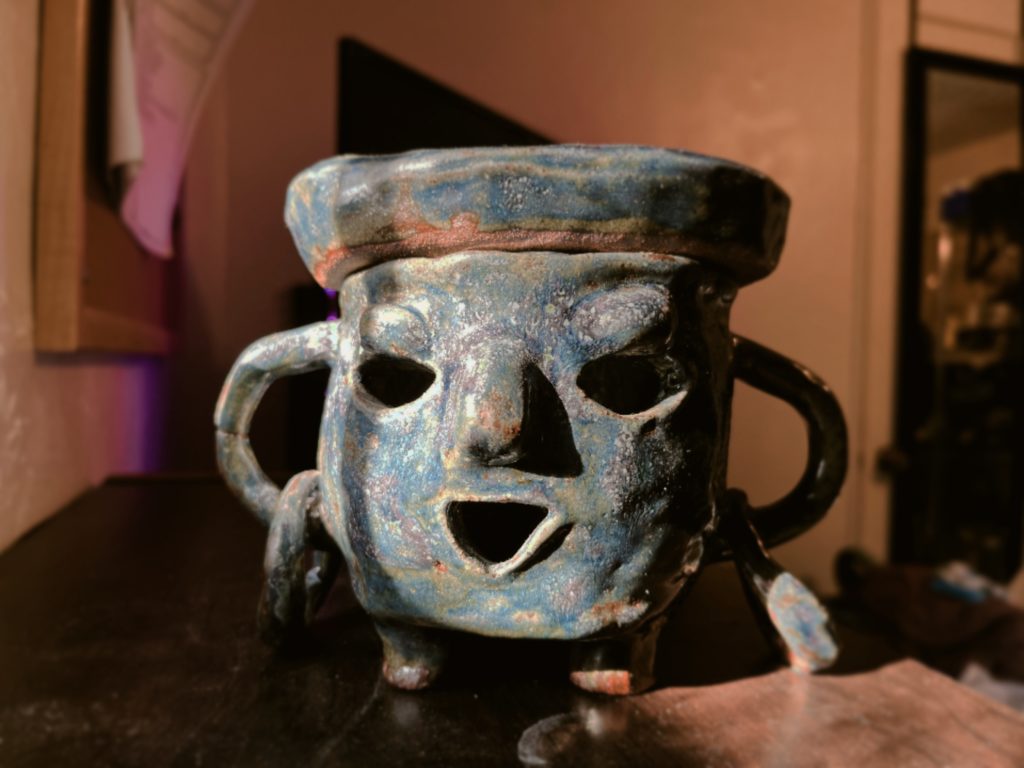Creating art is helping Erika Tenorio honor her Nicaraguan-Mexican Indigenous heritage and grandmother, who died from COVID in 2021.
Not only did the recent School of Art graduate work on a printmaking project during the fall semester titled “Linda Nicaragua, Mi Nicaraguita,” but one of Tenorio’s designs was chosen by the university’s Indigenous Cats Association to mark Indigenous People’s Day in October 2022.
Tenorio, who doubled-majored in Studio Art Illustration and Latin American Studies while minoring in American Indian Studies, was an inaugural scholar for the LAS department’s first-ever Central American Certificate Program.

In July 2021, Tenorio created a “caballa bayo,” a traditional Nicaraguan ceramic item, used to keep food on top of a dish warm. For the student’s paternal grandmother, it was the last image of Tenorio’s artwork she saw before dying two months later.
“My grandma said, ‘It’s beautiful to see you creating artworks about where you come from, whether it’s from this side of the family or your maternal family. It warms my heart – you are our family’s matriarch storyteller and will continue on the traditions,’” Tenorio said.

Tenorio’s father fled Nicaragua in the 1980s to escape fighting tied to the Contra War. Tenorio’s indigenous heritage draws from three communities: Chorotega (Nicaragua), paternal; and Tohono O’odham (Mexico) and Yaqui or Yo’eme (Mexico), maternal.
Born in Tucson, Tenorio saw few Nicaraguans or Central Americans while growing up in Arizona.
“Living in a predominant Mexican population, my father explained he had no choice but to assimilate to Mexican culture and Spanish when he arrived in the states because he stood out with his appearance and dialect,” Tenorio said. “In doing so, he forgot his Nicaraguan Spanish and culture for the most part.”
That’s one reason Tenorio is using artwork to “show the heritage I carry.”
For the independent study printmaking project, Tenorio worked with Professor Karen Zimmermann, assistant director of the School of Art, with topics of Indigenous history, identity, social politics and folklores.
“I’ll be carving my drawn images onto a linoleum block and carving it by hand, and finally moving the block onto the printmaking press,” Tenorio said. “The timing is tedious but very fun at the same time.”
As for her classes at the School of Art, “they (were) simply great,” Tenorio said. “I learned in different fields – design, typography, illustration, sculpture, ceramics, painting, figure drawing, etc. – and get to apply it to my artworks. Some professors made me appreciate more of what I am capable of and … to think outside the box.”
Tenorio is proud of the winning design for Indigenous People’s Day, which will be included on T-shirts.
“I included a part of myself into the design,” said Tenorio, referring to a red, green, white and black flower at the top – a design used by the Chorotegas in Nicaragua. “This also shows that a Latino-Indigenous person such as myself exists and is capable of creating any representation works, whether its Central American, Mexican or Indigenous related.”
Tenorio joined the university’s Native Student Outreach Access and Resiliency (SOAR) program as a mentor – teaching Indigenous students from the Southwest about painting and sketching. Tenorio also helped other SOAR instructors gain a connection with Indigenous college students in Guadalajara, Mexico.
“With my community connections of the Tohono O’odham nation and Pascua Yaqui nation by my spouse and his family (O’odham), my family, friends and Indigenous communities on social media, it’s been healing to reconnect and actively help my family and Indigenous community in general,” Tenorio said, “and help those who are Indigenous outside of the global north and teach others that our relatives exist outside of the global north.”
After graduating in December, Tenorio hopes to keep making ceramics, which the Chorotegas are known for in Nicaragua.
Tenorio recently created a ceramic work of a mother and child, which “is about me and my son!”
“It’s almost identical,” Tenorio said, “to the one I made in sculpture of a mother holding her infant child – representing my father when he was an infant and my grandmother.”
That bronze sculpture now rests with Tenorio’s grandmother at her tomb in Nicaragua.
Tenorio address the County Supervisors meeting
Tenorio read the Land Acknowledgement on Nov. 15, 2022, at the Pima County Board of Supervisors Meeting.
“Koi muriό, S-ke:g taṣ, Tui taewai, Buenas, my name is Erika Tenorio, I am Central-American Mexican Indigenous and come from the Chorotega, Yaqui, and Tohono O’odham communities respectively. I’m an undergraduate senior studying at The University of Arizona where I’m double majoring in Studio Art Illustration, Latin American Studies, and minoring in American Indian Studies. Many of my works, both essays and artwork wise, revolve around my Central American, Mexican, Indigenous backgrounds; therefore the representations and acknowledgement is very important in a colonial diaspora. Kupa kastai, S-ap’o, Chiokoe uttesia, Gracias!”
This article originally appeared on the School of Art website. Republished with permission.
